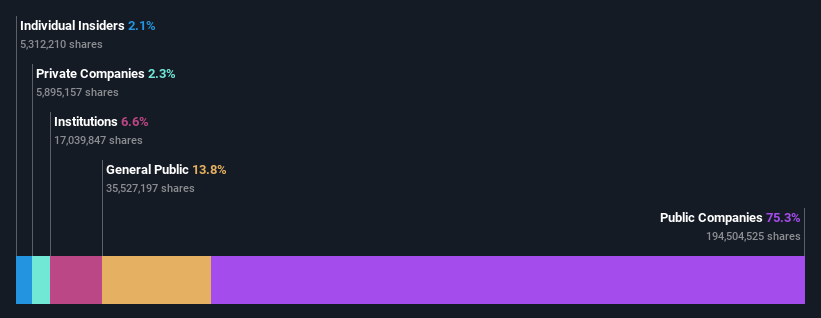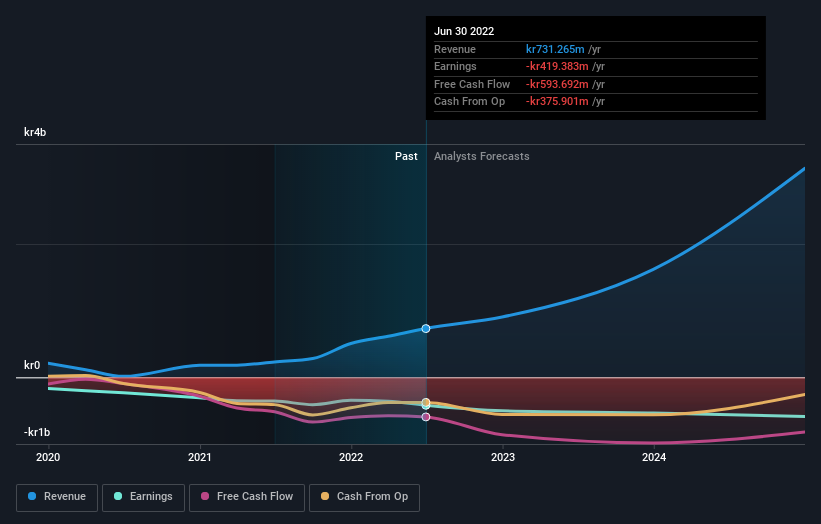Hexagon Purus ASA's (OB:HPUR) stock price dropped 11% last week; public companies would not be happy

If you want to know who really controls Hexagon Purus ASA (OB:HPUR), then you'll have to look at the makeup of its share registry. With 75% stake, public companies possess the maximum shares in the company. That is, the group stands to benefit the most if the stock rises (or lose the most if there is a downturn).
And following last week's 11% decline in share price, public companies suffered the most losses.
Let's delve deeper into each type of owner of Hexagon Purus, beginning with the chart below.
Before we look at the ownership breakdown, you might like to know that our analysis indicates that HPUR is potentially overvalued!

What Does The Institutional Ownership Tell Us About Hexagon Purus?
Institutions typically measure themselves against a benchmark when reporting to their own investors, so they often become more enthusiastic about a stock once it's included in a major index. We would expect most companies to have some institutions on the register, especially if they are growing.
Hexagon Purus already has institutions on the share registry. Indeed, they own a respectable stake in the company. This suggests some credibility amongst professional investors. But we can't rely on that fact alone since institutions make bad investments sometimes, just like everyone does. If multiple institutions change their view on a stock at the same time, you could see the share price drop fast. It's therefore worth looking at Hexagon Purus' earnings history below. Of course, the future is what really matters.

We note that hedge funds don't have a meaningful investment in Hexagon Purus. Hexagon Composites ASA is currently the company's largest shareholder with 73% of shares outstanding. This implies that they have majority interest control of the future of the company. For context, the second largest shareholder holds about 2.0% of the shares outstanding, followed by an ownership of 1.9% by the third-largest shareholder. Knut Flakk, who is the third-largest shareholder, also happens to hold the title of Member of the Board of Directors.
While it makes sense to study institutional ownership data for a company, it also makes sense to study analyst sentiments to know which way the wind is blowing. There are plenty of analysts covering the stock, so it might be worth seeing what they are forecasting, too.
Insider Ownership Of Hexagon Purus
The definition of company insiders can be subjective and does vary between jurisdictions. Our data reflects individual insiders, capturing board members at the very least. Company management run the business, but the CEO will answer to the board, even if he or she is a member of it.
I generally consider insider ownership to be a good thing. However, on some occasions it makes it more difficult for other shareholders to hold the board accountable for decisions.
Shareholders would probably be interested to learn that insiders own shares in Hexagon Purus ASA. In their own names, insiders own kr117m worth of stock in the kr5.7b company. It is good to see some investment by insiders, but it might be worth checking if those insiders have been buying.
General Public Ownership
The general public, who are usually individual investors, hold a 14% stake in Hexagon Purus. This size of ownership, while considerable, may not be enough to change company policy if the decision is not in sync with other large shareholders.
Public Company Ownership
It appears to us that public companies own 75% of Hexagon Purus. We can't be certain but it is quite possible this is a strategic stake. The businesses may be similar, or work together.
Next Steps:
I find it very interesting to look at who exactly owns a company. But to truly gain insight, we need to consider other information, too. Case in point: We've spotted 4 warning signs for Hexagon Purus you should be aware of, and 2 of them are potentially serious.
If you would prefer discover what analysts are predicting in terms of future growth, do not miss this free report on analyst forecasts.
NB: Figures in this article are calculated using data from the last twelve months, which refer to the 12-month period ending on the last date of the month the financial statement is dated. This may not be consistent with full year annual report figures.
Valuation is complex, but we're here to simplify it.
Discover if Hexagon Purus might be undervalued or overvalued with our detailed analysis, featuring fair value estimates, potential risks, dividends, insider trades, and its financial condition.
Access Free AnalysisHave feedback on this article? Concerned about the content? Get in touch with us directly. Alternatively, email editorial-team (at) simplywallst.com.
This article by Simply Wall St is general in nature. We provide commentary based on historical data and analyst forecasts only using an unbiased methodology and our articles are not intended to be financial advice. It does not constitute a recommendation to buy or sell any stock, and does not take account of your objectives, or your financial situation. We aim to bring you long-term focused analysis driven by fundamental data. Note that our analysis may not factor in the latest price-sensitive company announcements or qualitative material. Simply Wall St has no position in any stocks mentioned.
About OB:HPUR
Moderate and fair value.
Market Insights
Community Narratives




